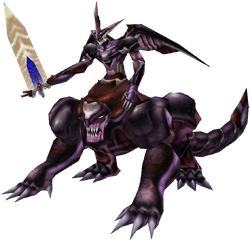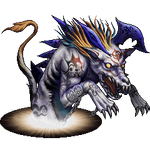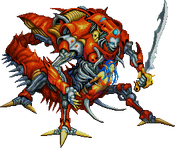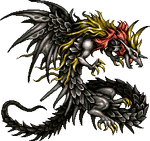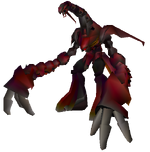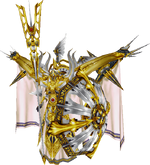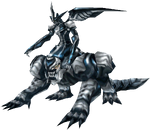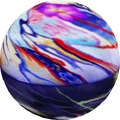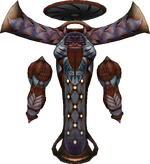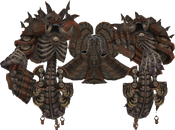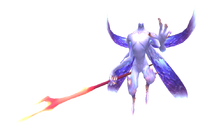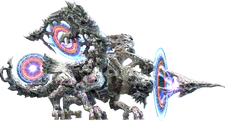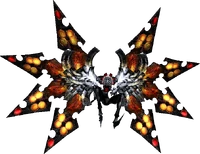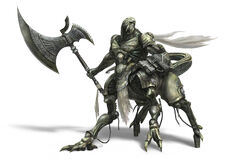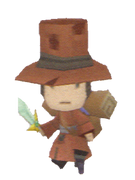A superboss is an optional boss that is very powerful, normally even more so than the game's final boss, and generally gives either large amounts of experience, rare items, or both. In the Final Fantasy series, they are usually found deep at the end of optional dungeons, or can only be found after a long series of sidequests. They normally have no bearing on the storyline, and their existence is rarely explained.
Likewise, the rewards gained from defeating a superboss are often not particularly useful—sometimes they give a key item as a proof of defeating the boss—as the player must already be extraordinarily skilled to defeat the boss in the first place, they thus have no need for further battle enhancements afterwards. Superbosses exist to challenge the player and give them something to do once the main storyline is finished.
Appearances
Final Fantasy
Template:Sideicon
Though actually only a very-rare random encounter, Warmech in the NES version can be considered a superboss, as its attacks are more powerful than the Four Fiends' combined. Its power has been toned down in remakes since Dawn of Souls.
Shinryu and Omega in the Lifespring Grotto, and Death Gaze in the Whisperwind Cove, are the superbosses that appear in the Dawn of Souls, the 20th Anniversary edition and mobile platform remakes based on the latter.
In the 20th Anniversary edition and remakes based on this version, Chronodia is an even stronger superboss, fought at the end of a new bonus dungeon.
Final Fantasy II
Template:Sideicon
Ultima Weapon appears as a superboss in the Dawn of Souls version.
In the 20th Anniversary edition and later versions of the game based on the 20th Anniversary edition, Phrekyos is a superboss fought to gain each character's ultimate weapon. He can be fought an unlimited number of times, provided the player first clears each Arcane Labyrinth and does not kill Deumion. Deumion is also a superboss, and is the one who summons Phrekyos to test the player's skill. He uses the Starfall attack the Emperor uses in the final battle.
Prior to later remakes that added additional enemies, some random encounters could be considered superbosses in the same sense as the Warmech in Final Fantasy. The Iron Giant is a rare random encounter found in Pandemonium, and marks the creature's first appearance in the series. A number of optional bosses (such as Astaroth and Beelzebub) guard chests that contain powerful items.
Final Fantasy III
Template:Sideicon
Iron Giant, a superboss in the 3D remake versions, can be found at the bottom of the optional "??? Dungeon," which is only available after unlocking the Mognet side quest.
Final Fantasy IV
Template:Sideicon
In the Game Boy Advance and PlayStation Portable ports, the new Lunar Ruins dungeon is unlocked after beating the main game. "Lunar" versions of Rydia's summons inhabit these caves. The actual superboss, Zeromus EG, lies at the end of the ruins. Another superboss, Brachioraidos, can be found on one of the ruins' lowest floors.
In the 3D remake versions, Geryon and Proto-Babil are the superbosses. Proto-Babil can be faced in New Game Plus after stealing the Dark Matter from Zeromus during the first playthrough, while Geryon is unlocked after beating the Elemental Archfiends in the Giant of Babil. Proto-Babil can be fought on the Moon's Surface, while Geryon can be fought either at the Giant of Babil or at Mount Ordeals.
Final Fantasy IV: The After Years
Template:Sideicon
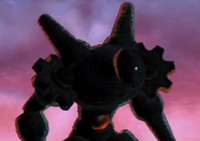
Lost Babil.
There are a total of three optional superbosses located in the Depths including Omega and Lord Dragon (otherwise known as Shinryu) from Final Fantasy V, and the Ultima Weapon from Final Fantasy VI. They have some different attack patterns and abilities and the player obtains powerful equipment after defeating them.
In Final Fantasy IV The Complete Collection for the PlayStation Portable, a new post-game boss called Lost Babil was added. The player must talk with Challengingway at the secret location on the True Moon to fight it. They must assemble three parties to fight three separate bosses, which consist of Lost Babil's torso, head and CPU. This could be seen as a reference or reappearance of previous superboss Proto-Babil.
Several of the lunar Eidolons—namely Lunar Dragon (who guards the Dualcast ability), Lunar Odin (who guards Ragnarok), Lunar Leviathan, and Lunar Bahamut—are exclusive superbosses for the mobile releases.
Final Fantasy V
Template:Sideicon
The original game included the first two superbosses to appear in the series, Omega and Shinryu. The Advance version adds stronger versions of these bosses, Omega Mk.II and Neo Shinryu, in the optional Sealed Temple dungeon. The final boss of the dungeon is also the final superboss, Enuo.
Final Fantasy VI
Template:Sideicon
Originally, Kaiser Dragon was planned to be the superboss in Final Fantasy VI, but was dummied for unconfirmed reasons prior to the game's SNES release. Deathgaze acts as a sort of superboss, due to its end-game level of power, but its difficulty is diminished since the player is not intended to defeat it in a single encounter but to weaken it over time.
In the game's Game Boy Advance and mobile ports, the Kaiser Dragon, a finished version of the dummied, boss CzarDragon, awaits the player in the heart of the Dragons' Den after the player has defeated the eight legendary dragons found within. Once Kaiser Dragon has been defeated, the true superboss of this game, Omega Weapon, will appear in its place.
Final Fantasy VII
Template:Sideicon
The North American, European, and International and PC versions of Final Fantasy VII feature two powerful superbosses. The Emerald Weapon appears at the Bottom of the Sea at random locations, grants the player a key item that can be traded into (some of) the most powerful Materia in the game. The Ruby Weapon, found by making contact with its head as it is sticking out of the sand on the world map in the Corel Desert near the Gold Saucer, grants the player a key item that can be traded into the game's most useful mount Chocobo.
In the original Japanese version these superbosses did not exist, and Diamond Weapon was not able to be fought, making Ultimate Weapon the strongest optional boss in the game.
Crisis Core -Final Fantasy VII-
Template:Sideicon
Minerva is an optional superboss and the final mission of the Great Cavern of Wonders group, Mission 9-6-6. She has the highest HP of any opponent and uses some of the strongest attacks in the game. As the player can battle her repeatedly, the boss can be used for item and gil farming.
Final Fantasy VIII
Template:Sideicon
The Omega Weapon is fought at Ultimecia Castle, and Ultima Weapon is found at the bottom of the Deep Sea Research Center. Ultima Weapon is based on Ultimate Weapon from Final Fantasy VII, and even wields Cloud Strife's best sword, which was a drop from its counterpart in Final Fantasy VII.
Omega Weapon lies hidden in Ultimecia Castle, and to reveal it the player must ring the bell in the Art Gallery to have it appear out of the purple cloud in the chapel. Defeating Omega Weapon grants the player the Proof of Omega.
Final Fantasy IX
Template:Sideicon
Ozma is found in the Chocobo's Air Garden after completing most of the Chocobo Hot and Cold sidequest. To hit it with Attack command, the Friendly Enemies must have been given their requested gem. Ozma is a large spherical entity that is released from an eidolon grave, giving credit to the idea it may be a forgotten eidolon that has thus lost its form. Ozma's unique attack pattern makes it especially difficult.
Hades is a hidden boss fought in Memoria. If the player finds and defeats him, they gain access to Hades's unique synthesis shop.
Final Fantasy X
Template:Sideicon
Ultima Weapon and Omega Weapon can be found in the Omega Ruins. They are relatively weak, and many of the Monster Arena creations are stronger than them, especially Nemesis.
The International, PAL, and the HD Remaster versions include the Dark Aeons, and once all of them have been defeated, the strongest superboss, Penance, appears in the Calm Lands. The Weapons are also tougher in the newer versions; Omega Weapon significantly so, putting him on par with some of the mid to high end Species Conquests.
Final Fantasy X-2
Template:Sideicon
The player can gain access to Via Infinito through Bevelle in Chapter 5 where many unsent characters became powerful fiends. The strongest opponent fought in the final floor is Trema, a former denizen of Yevon. Angra Mainyu in Bikanel Desert can be encountered multiple times during routine dig sessions, and can be fought and finally defeated after completing a quest in Chapter 5.
The game's International and HD Remaster versions includes the boss Major Numerus, a four-headed snake in another league relative to other superbosses. Although not quite as powerful, the fiend version of Shinra, titled Almighty Shinra, is also a superboss.
Final Fantasy XI
Template:Sideicon
Due to the nature of Final Fantasy XI being an MMORPG, virtually all in-game encounters are optional, including the main storyline and the final boss. There still exist a few event bosses and High Notorious Monsters that have been regarded as the most challenging encounters in the game. This list has changed over the years, as the game constantly evolves and new content will influence the difficulty of older ones.
Of the High Notorious Monsters (HNMs) in Vana'diel, the reigning superboss used to be Absolute Virtue from Chains of Promathia. It was notorious for being undefeatable without using some form of exploit as all prior successful methods of defeating it were patched out because it had not been killed the "proper way." Although it remained undefeated for years, within two months after the Level 80 cap raise, Absolute Virtue was finally defeated legitimately, but still poses a considerable challenge without the right alliance set-up.
Notable former HNM superbosses are Kirin, the first HNM that initially took nearly two hours to defeat, and Pandemonium Warden, which had its difficulty reduced due to it taking far too long to kill (a linkshell fighting for eighteen hours could not defeat it), an incident which generated a wave of bad press in gaming media.
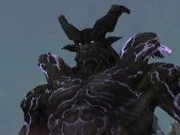
Dynamis Lord.
Dynamis Lord, the final boss of Dynamis, was formerly the greatest event superboss in Final Fantasy XI. It initially required a minimum of forty players to defeat under a specific strategy (Red Mages using Chainspell Stun) which is still the main viable strategy used to defeat him to this day. Without this, the Dynamis Lord can annihilate entire alliances of players with a single use of its many special attacks, the most damaging of which is Oblivion Smash. Since the updates to the Dynamis system when the level cap was increased to 90, a revamped version known as Arch Dynamis Lord has been introduced.
Currently, the toughest event superbosses in Final Fantasy XI are the Paramount Botulus and Paramount Gallu in the Hall of Mul chamber of Legion.
Other battlefields known for their difficulty include "Divine Might," a battlefield that pits an alliance against the Ark Angels, "Waking the Beast," where one must face off against Carbuncle Prime and the six celestial avatars, as well as "The Wyrmkin Descends," which is a battlefield against the Wyrmking Bahamut and his wyrm minions.
Other notable bosses include Odin, the boss of Einherjar whom as Odin II is much stronger after the first time he is defeated as Odin I, and the Delve bosses Tojil, Dakuwaqa, Muyingwa, Cailimh, Wopket and Utkux. Today, only these along with the bosses of Legion and the High-Tier Battlefields on Very Difficult mode are unsoloable.
Final Fantasy XII
Template:Sideicon
The Hell Wyrm can be fought in the Sochen Cave Palace after the conclusion of the Wyrm Philosopher sidequest. However, the Hell Wyrm is considered a mere prelude to the game's hardest superboss, Yiazmat. Yiazmat is an Elite Mark accessed after every other Mark in the game has been completed (except the Shadowseer). It is found at the Ridorana Cataract coliseum, and had the most HP of any enemy in the series until Lightning Returns was released, weighing in at just over fifty million (50,112,254). Yiazmat takes several hours for the average player to kill.
Omega Mark XII is a less time-consuming superboss that can only be accessed once the Mark for Yiazmat has been accepted.
Also, there are the light and dark Espers, Ultima—found at the top of the Great Crystal—and Zodiark—found at the end of the sealed area of the Henne Mines. Both are difficult due to high defense and devastating attacks.
Final Fantasy XII: Revenant Wings
Template:Sideicon Yiazmat returns sheltered within the dark confines of Midlight's Deep. Though not as powerful as its Final Fantasy XII incarnation, Yiazmat has gained the elemental affinity of Lightning and has retained most of its devastating attacks. It is a Ranged unit.
If the player completes all missions, the final boss and all of his minions will be on LV99, making for the game's hardest battle.
Final Fantasy XIII
Template:Sideicon
Vercingetorix is the final Cie'th Stone mission. For his mission to become available, the player must have defeated Missions 27 to 51. Vercingetorix is a flying Undying with 15,840,000 HP. Defeating Vercingetorix, and as such completing all missions, earns the player the Galuf's Grail Achievement/Trophy and the Exorcist Achievement/Trophy for defeating the final Undying Cie'th.
Another superboss is Long Gui, a massive oretoise that becomes available once the player has completed all of the fal'Cie Titan's trials as well as missions 56-62, at which point every oretoise on the Archylte Steppe except one will become a Long Gui or a Shaolong Gui. Long Gui has 16,200,000 HP, while its two front legs have 1,080,000 HP each. Defeating Long Gui earns the player the Adamant Will Achievement/Trophy.
Final Fantasy XIII-2
Template:Sideicon
The two most powerful enemies in the Archylte Steppe could be considered superbosses: The Long Gui from Final Fantasy XIII returns with the highest HP in the game. Another enemy, Yomi, is similar in appearance to, and uses the same battle tactics as Vercingetorix from the original game. One of the Undying, it's a one-of-a-kind Cie'th. Defeating it along with the Long Gui, Ochu, and Immortal will award the player the Big Game Hunter Achievement/Trophy.
Raspatil is a superboss found on the Ashensand of Oerba in 400 AF. It boasts 3,666,000 HP and can call other powerful Cie'th into battle, and defeating her awards the player 25,000 CP (the most of any enemy in the game) and the Fair Fighter Achievement/Trophy if the player defeated her in Normal Mode.
Optional superbosses released as downloadable content may be fought at the Coliseum upon purchase. These battles (most notably Snow, Gilgamesh, and Valfodr) are much more difficult than any battle encountered in the game's regular content. Both Snow and Gilgamesh sport 9,999,999 HP, while Valfodr increases in difficulty each time he's defeated, starting at 5,172,000 HP at level 1 and ending at 15,516,000 at level 99 (and a "HALVED" resistance to all damage, effectively the same as if he had 31,032,000 HP), in his fifth incarnation. For a fully-leveled party, only the DLC superbosses will still pose a significant challenge.
Lightning Returns: Final Fantasy XIII
Template:Sideicon The first superboss, Aeronite, must be defeated to complete the "What Rough Beast Slouches" side quest in the Dead Dunes. It appears as a "black hole" similar to rare enemies in XIII-2 and moves around the Giant's Sandbox on a timed schedule. It boasts 11,000,000 HP on Normal Mode, which means 17,500,000 HP when encountered in a Chaos infusion or fought on the Ark, 38,500,000 HP on Hard Mode, and 57,750,000 HP on Hard Mode when encountered in a Chaos infusion or fought on the Ark, giving it the highest potential HP of any Final Fantasy boss to date.
The second superboss, Ereshkigal, is encountered on the 33rd and final floor of the game's optional dungeon, the Ultimate Lair, which can only be played on Day 13 if the player completed enough quests to salvage an extra day. While its HP is lower—7,500,000 on Normal—it is less reliant on magic attacks than Aeronite, which means players cannot use Lightning's potential magic immunity to survive. As with Aeronite, Ereshkigal may be fought on the Ark with the same stats it would have if encountered in a Chaos infusion (giving it a maximum potential of 39,375,000 HP on Hard Mode).
On a New Game+ playthrough, the final boss, Bhunivelze, may also be considered a superboss, as his HP rearranges and his attacks become much stronger. Where he has four forms with HP of 600,000, 700,000, 900,000, and 1,050,000 on an initial playthrough, on a New Game+ he has two forms with HP of 4,000,000 and 5,000,000 (or 14,000,000 and 17,500,000 on Hard Mode)—nearly three times more. Additionally, his attack pattern changes (unlike Aeronite and Ereshkigal, who are no more or less aggressive on New Game+/Hard Mode). He becomes much more aggressive, uses more powerful spells, and requires a more specific strategy based on his current form.
Final Fantasy XIV
Template:Sideicon

Nael Deus Darnus.
The Legacy version of Final Fantasy XIV had two battles that were designed to be extremely difficult and a major challenge. The first one is the fight against Ifrit (Extreme), a required step for the Relic Weapons quest, where Ifrit gains the ability to use Hellfire multiple times during the battle, and all of his skills are reworked to affect bigger areas of the battlefield (some being completely unavoidable unless his horns are incapacitated).
The other fight is the hard version of the Seventh Umbral Era final boss, Nael Deus Darnus, an optional battle unlocked by completing the storyline, rewarding victorious players with the White Ravens earrings. The battle begins with Nael immediately charging Megaflare (which now deals around 7000 damage), requiring players to employ extreme damage mitigation tactics to survive the initial minutes of the fight.
In A Realm Reborn, there are many fights that are not part of the storyline. However, relatively few can be considered superbosses, as many can be cleared in a matter of minutes with an effective Duty Finder group. For example, players have access to hard mode mode versions of Ifrit, Garuda and Titan, which are required fights for accessing a job's relic weapon.
In patch 2.1, "extreme" versions of the primal boss fights were added, providing a third level of difficulty in which to challenge them. The hard mode version of Ultima Weapon is another superboss that debuted in this patch. Similarly, Odin appears in an extremely difficult FATE encounter, and got a designated Trial, Urth's Fount, in patch 2.5.
In addition to this, sufficiently well equipped players can take on the Binding Coil of Bahamut, a thirteen-part raid whose later floors, or "turns," require nearly perfect play of one's job. In particular, Twintania (Turn 5, the final boss of the original Binding Coil), Nael Deus Darnus (Turn 9, the final boss of the Second Coil of Bahamut), and the Final Coil of Bahamut. A harder version of the Second Coil, the Savage Second Coil, was released with patch 2.3, and currently contains the most difficult raid bosses in the game.
List of superbosses: Template:Col-begin Template:Col-2
Extreme Primals
- Garuda (Extreme)
- Titan (Extreme)
- Ifrit (Extreme)
- Good King Moggle Mog (Extreme)
- Leviathan (Extreme)
- Ramuh (Extreme)
- Shiva (Extreme)
Template:Col-2
Binding Coil of Bahamut
- Twintania
- Rafflesia (Savage)
- Melusine (Savage)
- The Avatar (Savage)
- Nael Deus Darnus
- Imdugud
- Kaliya
- Phoenix
- Bahamut Prime
Template:Col-2
Alexander
Template:Col-end
Other
- Ultima Weapon (The Minstrel's Ballad)
- Odin (Steel Reign/Urth's Fount)
Final Fantasy Tactics
Template:Sideicon
Elidibus is a mysterious character similar to the Lucavi fought in the final level of the optional dungeon, Midlight's Deep, but he is not significantly more difficult than the final boss, Ultima. The challenge comes from winning the battle while learning Zodiark and/or obtaining the Byblos.
Final Fantasy Tactics Advance
Template:Sideicon
The Corrupt Judges await as a post-final boss challenge. Though they are technically classified as superbosses, they exist in a gray area of this term, as this classification is based on them being encountered after defeating the game's final boss, Li-Grim. Li-Grim, however, remains the game's most difficult boss.
Final Fantasy Tactics A2: Grimoire of the Rift
Template:Sideicon
The Upsilon class of enemy, one being the red Smoldering Incubus, a rather weak superboss, can be fought in the optional Heritor ability quest tackled before the final ability quest. It is only a prelude to the game's true superboss, Magick Weapon, a possible incarnation of the Omega Weapon (it was built on the same model, like Smoldering Incubus, a possible incarnation of Ultima Weapon). It can be fought after defeating the Neukhia, the final boss.
Clan Cinquleur members also are superbosses, as the second and third time the player encounters them, they are level 99 and are very difficult to defeat (albeit not as difficult as Magick Weapon). Other superbosses are the bosses of Brightmoon Tor sidequest, and the clans of "The Final Mission," which encounter the party at level 99, and ban the summoning of scions (they can still be summoned, but if the player uses one, they lose the judge's protection).
Final Fantasy Type-0
Template:Sideicon
Nox Suzaku is a superboss that appears only from the second playthrough. When Nox Suzaku appears, it becomes impossible to harvest any phantoma until either Nox Suzaku is defeated or goes away after absorbing enough phantoma. The player needs to ram into the Nox Suzaku with an airship to begin the battle in an alternate dimension. Even though defeating all the shades that appear will cause Nox Suzaku to leave, it will not defeat it. The only way to damage Nox Suzaku is to make it appear first by having a party member die, then attacking it in the brief moment it comes to collect the party member's phantoma.
Gilgamesh reappears in his eight-armed form as a much easier superboss than Nox Suzaku. He appears in one of four locations in Orience, and is available to fight from the third playthrough after Chapter 5. He behaves much like his earlier counterparts, requiring breaksights to do sizable damage, but also has a few more attacks added.
Cosmic Malboro may be considered a superboss, being found at the top of the Tower of Agito. Its attack patterns are identical to a malboro's, using Bad Breath and spewing Cosmic Sludges. In this way, it may be considered only a very strong normal enemy rather than an actual superboss.
Vagrant Story
Template:Sideicon Asura appears as the superboss found at B3 of the Iron Maiden Dungeon. She is difficult to deal damage to and has the highest HP in the Game at 999. Story-wise she is the reason for the filling of the Iron Maiden with The Dark (and is also the namesake of the dungeon) after being imprisoned and experimented on by Müllenkamp.
Final Fantasy Crystal Chronicles: My Life as a King
Template:Sideicon Omega appears as the 50th floor boss in the optional DLC dungeon Infinity Spire. He is far more powerful than regular Infinity Spire floor bosses and uses an attack called Wave Cannon that will hit every Adventurer inside Infinity Spire for 1,000 damage, even if they are not fighting him (although any Adventurer not in battle at the time cannot be knocked out by it). Defeating Omega rewards one of the Adventurers who survived the battle with the Omega Symbol, a level 50 necklace that adds +27 to all stats, as well as a regular medal for completing the floor.
A Wyrm appears as the 99th floor boss of the same dungeon. It is by far the most powerful opponent in the game and is similar to Omega except even more powerful. It has an attack called Tidal Wave that will hit every adventurer in the dungeon for 3,000 damage. On defeat, one surviving Adventurer in the battle will get the Ragnarok Prime, a sword that gives +52 to all stats, as well as a regular medal for completing the floor.
These two superbosses are the only ones in the entire series the player does not get to fight directly.
Final Fantasy Crystal Chronicles: Echoes of Time
Template:Sideicon Great Galdes, the final boss from Final Fantasy Crystal Chronicles: Ring of Fates returns as a superboss in Echoes of Time. The battle is identical to the Ring of Fates encounter, although the difficulty is ramped up significantly.
Dissidia Final Fantasy
Template:Sideicon Inward Chaos is the final storyline and pits the player against all twenty-two playable characters of escalating level, ending with a battle with Chaos at Level 110. Opponents ranging from Level 100 to Level 150 can be fought in the Blackjack Course in the Duel Colosseum, including a Level 130 Chaos. At these levels opponents have much higher stats than the player's character, and due to being at a higher level gain a bonus to their base Bravery.
Dissidia 012 Final Fantasy
Template:Sideicon The game's superboss is provided by Feral Chaos. At the end of Confessions of the Creator, the player must battle a Level 130 Feral Chaos with over a hundred thousand HP and unique accessories that grant him powerful support effects. A Level 95 Feral Chaos can be fought earlier in the same storyline as a manikin of the true boss, and is itself the most difficult opponent in the game up to that point.
A Level 100 Feral Chaos serves as the boss of the Labyrinth, encountered on the 98th floor guarding the exit to the final floor, where the last piece of the Final Strike set can be acquired.
Final Fantasy Legend II
Template:Sideicon
The Haniwa functions as a superboss similar to Warmech from the original Final Fantasy, in that it appears rarely randomly in a certain area, which in this case happens to be the final area of the game. It's a very dangerous enemy, but is arguably not as powerful as the final boss.
It can use Quake and Flare against the party, but can drop the powerful Seven Sword, which Haniwa will occasionally use against the party during battle and it will deal damage in the high thousands.
Final Fantasy: The 4 Heroes of Light
Template:Sideicon
The game has six optional bosses that could be consider superbosses.
Each boss is located at the 100th floor of each bonus tower:
- Krinjh: Located at the top floor of the Moonsand Ruins.
- Torte: Located at the top floor of the Holy Tree Tower.
- Rolan and Rekoteh: Both located at the top floor of the Mysterious Lighthouse.
- The Adventurer and the Faithful Fox: Both located at the top floor of the Trial Tower.
Bravely Default
Template:Sideicon The Adventurer appears very similar to her incarnation in 4 Heroes of Light as the superboss in Bravely Default. She is also accompanied by her companion Fox. The Adventurer is found in the end-game dungeon, Dimension's Hasp, behind a fake wall at the bottom of the dungeon.
Final Fantasy Dimensions
Template:Sideicon Final Fantasy Dimensions has three post-game superbosses all accessible through Gladiators' Hall:
Each superboss can gain levels, up to a maximum level of 6. Adamantoise and Omega Weapon gain 1 level every two times they are defeated, while Gigantuar gains 1 level every three defeats.
Template:Sidequests

